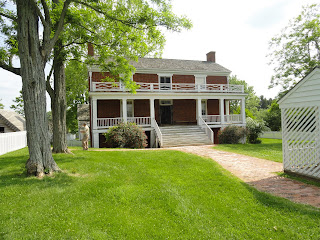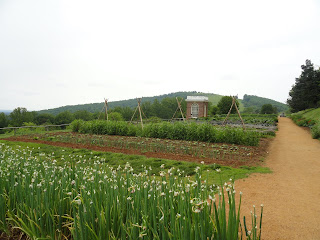Wednesday, May 11 th, Danny and I left Pigeon Forge headed to Gordonsville, Virginia with plans to stop and tour Appomattox Court House on the way. This historic tour was probably one of the highlights of our whole trip and was a pleasant surprise to us. We always assumed that General Lee surrendered to Grant at a court house in Appomattox, Virginia. Well, that was wrong. Appomattox Court House is a small village a few miles from Appomattox, Virginia. The whole village has been preserved as a museum. The streets are dirt and the buildings original.
General Lee actually met with General Grant at the McLean House in this little village to discuss the surrender. It was drawn up at that time, and General Lee made a correction in document using a pencil that is on display. Later that day, the surrender was signed, and General Lee and General Grant watched as the Confererate soldiers marched up Surrender Road to give up their weapons and their flag. The Federal soldiers lined the road and stood at attention as the Confederates marched in front of them.
The Federal soldiers printed over 28,000 parole passes for the Conferderates in the Clover Hill Tavern there in Appomattox Court House. It took three days for the printing to be completed and then the Confederates were allowed to travel home.... mostly on foot as they had no means of transportation.
Appomattox Court House is a quiet and peaceful site now, and while there, I felt a deep respect for all the soldiers who were involved. Below are some of the photos that I took showing the McLean House, the court house, Surrender Road, Clover Hill Tavern, and some of the slave quarters behind the McLean House.

This is the McLean House where the surrender was signed. A military scout was sent to the village to find a place where the two generals could meet. This was a suitable site and the owner was present to give permission. The structure in front of the house was a well.

General Lee sat at the marble topped table on the left and General Grant sat across the room at the smaller table during the drawing up and signing of the surrender papers.

This is Surrender Road leading into the village. It was here that the Confederates stacked their weapons and gave up their flag while the Federal troops stood at attention.

Surrender Road led into the village and around the courthouse which you in this photo.

Danny in the yellow shirt is walking to tour the slave quarters behind the McLean House. The cook's family inhabited the larger white structure which held the kitchen and the living quarters. The smaller white structure was living quarters for two slave families.

This is Clover Hill Tavern where the 28,000 parol passes were printed for the Confederates.

The printing presses that were used to print the passes.
We stayed until 5:00 PM when they closed, so we headed on to Gordonsville, Virginia to stay in the Shannendoah Crossing Resort. More of our trip is to come in the next blog.
 On Thursday May 12, 2011, Danny and I got an early start on our day of touring Charlottesville. First stop was Monticello, Thomas Jefferson's home. His innovative ideas were extensive: the stew stove in the kitchen for slow cooking, the fish pond for keeping the catch alive
On Thursday May 12, 2011, Danny and I got an early start on our day of touring Charlottesville. First stop was Monticello, Thomas Jefferson's home. His innovative ideas were extensive: the stew stove in the kitchen for slow cooking, the fish pond for keeping the catch alive  until needed, the ice cellar filled with ice from the river in the winter and kept through the summer, the pulley weighted calendar in the entrance, the clock with only the hour hand attached to a bell that alerted the field hands of the time, the beds built into the wall to save space and on and on. Mr. Jefferson continued to remodel the home throughout his life. Mulberry Row was a road next to the house where the slave quarters and the vegetable gardens were located. It was lined with mulberry trees and overlooked the river valley below. We enjoyed our guides' talks as they led us through the house and through the gardens. Quite an impressive place!
until needed, the ice cellar filled with ice from the river in the winter and kept through the summer, the pulley weighted calendar in the entrance, the clock with only the hour hand attached to a bell that alerted the field hands of the time, the beds built into the wall to save space and on and on. Mr. Jefferson continued to remodel the home throughout his life. Mulberry Row was a road next to the house where the slave quarters and the vegetable gardens were located. It was lined with mulberry trees and overlooked the river valley below. We enjoyed our guides' talks as they led us through the house and through the gardens. Quite an impressive place! Clock on front porch.
Clock on front porch. Here's a view of the back entrance .
Here's a view of the back entrance . Fish pond near the kitchen to keep fish until needed.
Fish pond near the kitchen to keep fish until needed. Danny in the observation structure where Mr. Jefferson would stand to look out over his land.
Danny in the observation structure where Mr. Jefferson would stand to look out over his land. Mulberry Row where slave quarters were located.
Mulberry Row where slave quarters were located. Extensive vegetable garden.
Extensive vegetable garden. Front view of the Administration Building which fronts a busy Charlottesville street.
Front view of the Administration Building which fronts a busy Charlottesville street. The beautiful administration building with beautiful columns on the portico (covered we think because parts were in danger of falling...I hope they will be repaired) and topped with a dome.
The beautiful administration building with beautiful columns on the portico (covered we think because parts were in danger of falling...I hope they will be repaired) and topped with a dome. The interior of the dome section of the administration building.
The interior of the dome section of the administration building. The lawn was surrounded by these pretty old buildings. The two story buildings were used for classes on the lower level and the professors lived above. Students lived in rooms between the class buildings. Today, only a select group of prestigious senior students are privileged to live in these rooms.
The lawn was surrounded by these pretty old buildings. The two story buildings were used for classes on the lower level and the professors lived above. Students lived in rooms between the class buildings. Today, only a select group of prestigious senior students are privileged to live in these rooms. A view of the lawn from the steps of the administration building.
A view of the lawn from the steps of the administration building. One of the student's rooms fronting the lawn. Take note of the bed on a loft over the windows. The students who live here must exit their rooms and go to a communal bathroom behind the buildings. Don't think would want the privilege of living in one of these rooms!
One of the student's rooms fronting the lawn. Take note of the bed on a loft over the windows. The students who live here must exit their rooms and go to a communal bathroom behind the buildings. Don't think would want the privilege of living in one of these rooms! 













